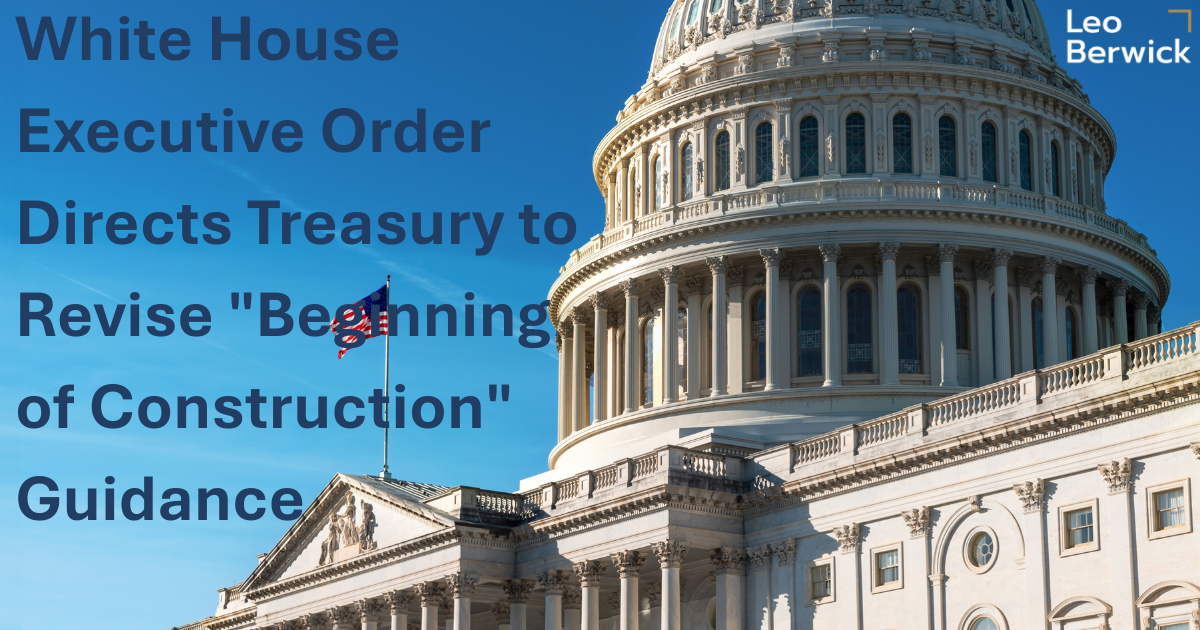July 9, 2025 |
On July 7th, 2025, President Trump issued an executive order requiring certain federal agencies to produce guidance that will govern the enforcement of the termination of federal subsidies for wind and solar projects introduced in the One Big Beautiful Bill Act. The forthcoming guidance is expected to include, at the very least, clarifications around how to determine when a wind or solar project has started construction. That start of construction determination has many implications for a project’s eligibility for federal incentives.
On July 7, 2025, the White House issued an Executive Order (“EO”) that directs the Treasury Department to take all actions necessary to “strictly enforce the termination of the clean electricity production and investment tax credits under sections 45Y and 48E of the Internal Revenue Code for wind and solar facilities” (Ending Market Distorting Subsidies for Unreliable, Foreign‑Controlled Energy Sources – The White House). Although the EO may have broader implications, it provides that such enforcement will include issuing new and revised guidance as it relates to the “beginning of construction” rules. Those rules inform myriad aspects of the federal tax credits that might be generated from placing into service certain electricity generating facilities (e.g. wind and solar facilities).
This EO follows the One Big Beautiful Bill Act (the “OBBBA”). As Leo Berwick has previously discussed (A Summary of the Tax Credit Implications of the One Big Beautiful Bill Act), the OBBBA introduces limitations for projects that enjoy material assistance from or have shared ownership with foreign entities of concern (“FEOC”) and accelerates the phase-out for the clean electricity production (“PTCs”) and investment tax credits (“ITCs”) under Sections 45Y and 48E, respectively. The EO may result in the eventual issuance of guidance that modifies the rules governing what it means to begin construction through either physical work of a significant nature (“PWSN”) or the 5% safe harbor as previously described in IRS Notices 2013-29, 2018-59 (the “BOC Notices”) and elsewhere. Under the OBBBA’s accelerated phase-out timeline, wind and solar projects that:
- Begin construction prior to December 31, 2025 are not subject to FEOC limitations and can claim ITCs or PTCs if placed into service within 4 years of beginning construction
- Begin construction between January 1, 2026 and July 4, 2026 are subject to FEOC limitations but may be able to claim ITCs or PTCs if placed into service within 4 years of beginning construction
- Begin construction after July 4, 2026 are subject to FEOC limitations and can only claim ITCs or PTCs if they are placed in service on or before December 31, 2027. If placed into service during 2028 or later, such projects are not able to claim ITCs or PTCs.
The EO includes explicit instruction to Treasury to “restrict the use of broad safe harbors unless a substantial portion of a subject facility has already been built.” It remains to be seen what language might be included in the forthcoming guidance, but OBBBA codified that the beginning of construction for any given project “shall be determined pursuant to the rules similar to the [BOC Notices].” The use of the phrase “similar to” might imply forthcoming guidance that deviates from the content of the BOC Notices in meaningful ways, but at this time we can only speculate. However, given the language of the EO, we might anticipate increased scrutiny on all wind and solar beginning of construction efforts as well as modifications to the methods and thresholds described in the BOC Notices.
Beyond tax credit guidance, the EO also directs the Department of the Interior to review and revise any regulations, guidance, policies, and practices that provide preferential treatment to wind and solar facilities compared to dispatchable energy sources (i.e. fossil fuels) within 45 days of the OBBBA’s enactment. Both the Secretary of the Treasury and the Secretary of the Interior are required to report their findings and planned actions to the President within 45 days of the EO’s date.
Until clarifying guidance is issued, there will be increased uncertainty as to how wind and solar stakeholders should pursue their start of construction efforts to maximize federal tax credit opportunities with minimal accompanying restrictions. We advise clients to promptly assess their project timelines and qualification strategies. Our team is available to discuss specific project implications as this critical guidance unfolds.
